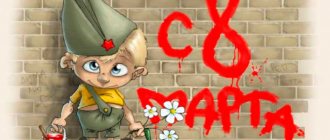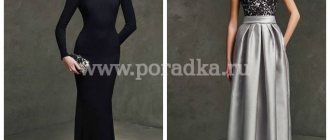We see fast hand movements, swaying hips, cocky raised eyebrows and colorful clothing - but this is just the tip of the iceberg that could describe the voguing dance style. To be more precise, vogue is much more than a dance; rather, it is an art, a sport and a way of life. Heroine decided to figure out where this trend came from, which dancers are worth following, and why even those who have never danced should try it.
Where did wog come from?
Initially, voguing was danced mainly by black drag queens from Harlem in the 70s. They admired the rich white women in fur they saw on the streets and tried to imitate them in closed nightclubs. Exaggerated gestures, complex poses - all this was a way to caricature the wealth and privilege of women. After some time, they began to add makeup, feminine clothes and complex hairstyles to their scenes, and the result of a series of posing was called “vogue” in honor of the famous fashion magazine.
For drag queens of the time, voguing became an escape, a way to forget the pain and oppression they faced. But besides this, it was a celebration of their Beauty.
— Kevin Omni Burris
The most valued quality of a voguing performer was realness - realism, the ability to look heterosexual in clothes that are not of the same gender. Ruthless judges and a screaming crowd reward only the one who completed the task best. Gradually, vogue began to acquire new elements, gymnastic tricks, gestures and clothing styles. Harlem balls became a new culture for black people who did not want to live a modest lifestyle in the ghetto. And in order to avoid clashes with street gangs, community members began to unite in “houses” - a kind of dormitory.
What is home?
While gangs used guns to decide who was boss in the area, the queer community fought through dance. Already in the 80s, the first houses appeared, which later became legendary: House of LaBeija, House of Dupree, House of Xtravaganza, House of Ninja, House of Omni and House of Ebony.
Every home must have a Mother and Father, and to occupy this position, one had to be a “legend” of balls with a dozen trophies. The children were members of the community who had lost a roof over their heads and no family support. Rejected gays, trans and lesbians could unite into a new family, take new surnames and together maintain life in the same apartment, jointly earning money to pay bills and food.
In turn, the organizers of parties and balls monitored the safety of all members of the community, ignoring internal conflicts at the balls - none of the “children” should have been hurt on the street or died without the ability to pay medical bills.
Vogue became a way to express one's identity through an artistic form in a situation where external forces threaten life itself. The AIDS epidemic in the mid-1980s hit the community hard. Despite the fact that at that time people did not openly admit their orientation even to themselves, gays, lesbians and bisexuals became the group with the highest risk of getting HIV infection. The dancers joked: I have lost 454 friends due to this disease. No, 455, I forgot about Paris! Some balls were dedicated to the fallen members of the community, others were a way to escape from the harsh reality and enjoy the precious days they had left.
In the 90s, the culture began to spread in Paris, and from there throughout Europe. The concept of houses has taken root much less well there, because the need for support among LGBT people in Europe is much less than among people of color in America. In Russia, the house began to have a slightly different context - it usually means the high status and dancing skills of the dancers, and in some houses there may not even be a single person belonging to the LGBT community.
Read on topic: How to be tolerant of LGBT people if you yourself are heterosexual
Basic dance movements for physical health
By adding physical activity to your life, it should be noted that you gain harmony, improve self-esteem and mood. Plus, it's a good activity for people at risk of heart disease.
However, do not forget about the load. Perhaps at first you need to perform light dance movements , but even then you can feel the positive results in the form of a surge of energy. Scientific studies even report this. Italian scientists observed a group of people who danced every week. As a result, not only their physical condition improved, but they also became more energetic.
At first, when learning movements for beginners, you should not overdo it. Only by gradually increasing the load does the body gain flexibility, endurance and strength.
Most classes begin with flexibility and stretching exercises. When performing the dance movements themselves, all muscle groups will be involved. Styles such as ballet or jazz, and not only, include jumping, which develops strength and endurance.
Why did voguing become popular outside the LGBT community?
Gradually, people who had nothing to do with dance or queer topics began to show interest in voguing. In 1989, host Suzanne Bartsch hosted the Love Ball as a way to raise funds to fight AIDS. She liked to attend such events, as she herself said - they know how to create something out of nothing. This ball turned out to be a breakthrough in the fashion industry, and the girl began to encourage brands to support houses and compete with each other. The next party was attended by Iman, Naomi Campbell and Madonna, and it was after this ball that the main musical hit of 1990 appeared - the song Madonna - Vogue. A year later, the documentary film “Paris is Burning” was released, which received the main prize from the jury at the Sundance festival and grossed $4 million at the box office. Some members of the community condemned it because the director of the film was a rich white woman, but it was thanks to her work that even those who were not directly affected by this topic learned about voguing.
Which stars are into vog?
Gradually, Vogue's influence on modern pop culture increased. The reality show RuPaul's Drag Queen Race has been released, increasing the visibility of the transgender community as a whole. Singer FKA Twigs began demonstrating voguing moves at all her concerts. One of Nike's latest advertising campaigns put voguing on the same level as sports competitions. Amazon legend Leiomi appeared in Will Smith's daughter Willow's video for the song "Whip My Hair", and ten years later she appeared in a music video again, this time in Russia, in the video "Mood Color Blue".
Foreign dancers look with surprise at what is happening at Russian balls. Vogue has become a key trend in most dance schools, and even children have begun to master it - just take the viral performance of Eva Uvarova, one of the participants in “Dancing on TNT.” At the same time, these performances were not a protest or an attempt to increase the visibility of the LGBT community. According to some performers, it is strange to dance and have fun without thinking about the fact that gays continue to be regularly captured, tortured and die in some republics of the country.
What dances are in fashion now?
Through dance you can express a lot: an era, national color, mood, feelings... A dancing person opens up new facets of self-expression, gains confidence, and for many, dancing is the best option for maintaining physical fitness.
What dance styles are popular in Astana today? Saltanat MAKHANBETOVA, a choreographer at one of the dance studios in the capital, answered this question .
Popular movements
According to her, now such trends as pole dance, strip dance, contemporary, wаacking, twerk are gaining great popularity. — Pole dance is characterized in different ways: pole dancing or pole gymnastics (acrobatics). For me, this is primarily a sport, because here you need to work with your own weight. In this direction, the muscle corset is very powerfully worked out, endurance, balance and strength of character increase. Rapidly developing, pole dance has branched into several subtypes: pole sport is acrobatics, gymnastics on a pole, pole fitness is exercises using a pole. Here the pole works as a simulator - to work out certain muscle groups,” says Saltanat. In addition, according to our interlocutor, such trends as contemporary and wacking are also very popular in the capital.
What are the benefits of dancing?
Dancing classes have a positive effect on a person’s health and psychological state. According to Saltanat Makhanbetova, dancing has a strengthening and restorative effect on the body. The frequency of colds decreases because dance exercises train the respiratory system. They increase blood circulation, which, in turn, increases the supply of oxygen to the body and has a beneficial effect on the activity of almost all internal organs. Dancing improves coordination of movements and strengthens the vestibular apparatus, helping to burn extra calories. In addition, regular dance classes with complex movements improve brain activity and memory, and reduce the risk of Alzheimer's disease.
— Dancing slows down the aging process of the body, because it’s not for nothing that they say that movement is life. And, of course, they affect a person’s psychological state, as they help produce happiness hormones - endorphins, improve mood, help fight stress, depression, fears, and nervousness,” says the choreographer.
Young Astana residents choose dance mix, jazz-funk, hip-hop, Latin, twerk, wacking, ballet. Adults prefer oriental dancing and zumba. The average age of dancers is from 18 to 35 years.
The cost of dance passes is from 7 to 25 thousand tenge, depending on the style of dance and time of classes. There are studios for adults, children and mixed ones.
Pole dance is a dance style in which the performer performs on pylons (poles), combining elements of choreography, artistic gymnastics, and acrobatics.
Contemporary is an open direction. Each choreographer takes any technique as the basis of a dance style, but at the same time passes it through his body, obtaining a new style, his own interpretation, and language of movements.
Waacking is a bright and emotionally expressive style of modern dance (from “waack” - “waving your arms”). The dancer makes very fast, energetic, clear and sharp movements with his arms and legs, while maintaining an absolutely free, relaxed body position. As a result, the dance resembles an artistic game.
Twerk (booty dance) is a style of dance in which the movements of the hips, abdomen and arms are actively used, while the rest of the body is almost motionless.
Zumba is a dance fitness program based on popular Latin American rhythms. Zumba classes are often held free of charge in the parks of the capital.
Aigerim SHALDANBAEVA
Tags Favorites
How do voguing styles differ?
Most often, voguing is divided into three categories, and each style has its own nomination at the ball. Vogue performers can be professionals in only one direction, or they can express themselves perfectly in any style; there are absolutely no restrictions in this regard.
Femme
The most famous substyle of voguing is called Femme, and it is especially popular in Russia. Femvog dancers demonstrate exaggerated feminine movements, combining them with ballet and jazz step dances. The style is further divided into two categories: Soft and Dramatic . The first focuses on femininity and grace, the second on tricks and speed. Typically, judges evaluate several key elements - duckwalk and catwalk, spinning, floor performance, drop.
Duckwalk has been known to us since school days as “walking in single file”, but it needs to be done on half toes and with a perfectly straight back, throwing the leading leg forward. Catwalk, or cat walk, is an exaggerated walk along the catwalk with emphatically raised hips. Floor performance - elements that are danced on the floor. Spins - a series of rotations that often ends in a fall - drop . Dancers call the drop point at the end of a sentence because it is usually done at the very end of a measure and allows a new sentence to begin in the performer's story.
Old Way
Old School Voguing represents '80s voguing, focusing on grace, precision, and precise poses. It is he who can be seen in Madonna’s “Vogue” video or the Pose series. Sharp angles, emphatically straight posture, and every movement should be performed as if this particular frame would end up on the cover of a glossy magazine.
New Way
"New School" focuses less on posing and more on working with unusual music and flexibility. Unnaturally curved limbs, working with geometric shapes, splits and pantomime - sometimes New Way dancers at balls look like real aliens.
What can you watch about Vogue?
So far, very few films and TV series have been shot on this topic. The most famous documentary work about the Vogue style was made back in 1990 - “Paris on Fire”. This film follows the lives of several transgender people who live in France, their homes and the support they can only receive within the community.
The footage from another documentary, 2006's The Way I Look, was also taken in the '90s, but the director decided to document how dance and ballroom culture changed over the course of a decade.
Last year, Ryan Murphy's series Pose was released, which with humor and scale tells about the lives of fictional characters participating in the balls. They cannot cope with social injustice alone and decide to create a home, become a real family to each other and look for new opportunities for self-expression in the face of financial problems. Right now the fX channel is broadcasting the second season of the project.
Oriental, Indian, Irish
If you are interested in the culture of different nations and the exquisite music of other cultures, try Oriental, Indian, Irish, Gypsy and Tatar dances.
Belly dance
Ekaterina Chernyshova
| Anna Kudrina | Detailed video lesson on basic movements of oriental dances in Russian. |
| Anna Ilyina | A simple combination of basic movements in Russian. |
Belly dance schools and studios
Indian dances
Dil Mera Muft Ka
| Harish Gangani - Kathak | Video lesson in Russian from a 7th generation temple dancer. You will learn a brief history of the dance and all the basic elements. |
| Julia | A few basic Bollywood moves in Russian for beginners. |
Indian dance schools and studios
Irish dances
Gypsy dancing
Gypsy dance. Solo by Natalia Kulishenko
| Venus Ferrari | Video lessons on basic gypsy dance movements in Russian. Suitable for beginner dancers. |
| Maria Shashkova | Teaching the basic elements of gypsy dance in Russian. |
Gypsy dance schools and studios








